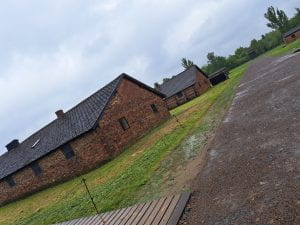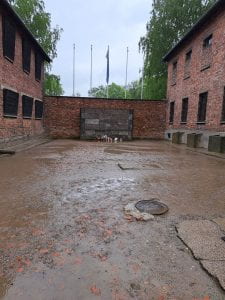Seeing History Firsthand
A Historian’s Blog of Poland
Meg Brosneck

Barracks at Auschwitz II-Birkenau
Poland is a beautiful country to visit, but its beauty was not the reason for our visit. The main reason belonged to one of the most horrific places in history: Auschwitz-Birkenau.

Bunks in the barracks
Though the story of Auschwitz is well-known in history classes, the true scope of its horror cannot be understood without visiting the location itself. Some of the buildings were transformed into museum exhibits. Most of these are on the main camp, and they were the first places we visited. While they included some important photos and explanations, the most important exhibits came from the Holocaust victims’ personal belongings. Entire rooms are dedicated to displaying the pots and pans, shoes, or suitcases a fraction of the victims had brought with them. They are all that remains of entire families. The Nazis collected everything the Jews had to sell or distribute after they murdered them. While the physical items were horrible to look at, nothing came close to the room filled with several tons of human hair. The Nazis shaved their victims heads and sold their hair as a product, and Auschwitz still has some of it behind glass cages. No pictures were allowed.

The Death Wall
We continued through the rest of the camps and walked along the muddy roads where over a million people suffered and died. This explained more than any textbook ever could. We saw the buildings the Nazis forced the victims to build and then sleep in, four to seven people crammed into each tiny, cold, muddy, wooden space. We walked through the courtyard in which they executed countless people. Most of the buildings were well preserved, and our tour guide was marvelous in his explanations of what happened at each facility. Downstairs, in the basement of the infamous Block 11, we saw the standing prison cells the Nazis would cram four people inside all night. There were no pictures allowed and we were rushed through the sites, but that location impacted me more than any others. You can read all of the books you want, view all the images in existence, but until you stand in front of the torture chambers yourself, it will not sink in. This is why preservation of these sites is so important; they are physical proof of what happened and irreplaceable sources for historians and the public alike.